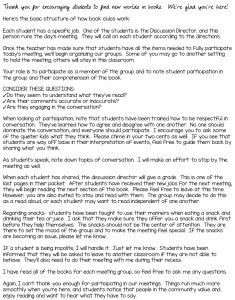Book clubs can be challenging, but a few important hacks can make for a fun, relaxing experience. One of the best tips I have for running book clubs in your classroom is to find other people to help during meeting time. This does take time, but it’s so worth the effort.

Why take the time to find volunteers?
The most important reason I take my time to find people to help is that my students take their book club reading and work more seriously if they know there are others who will be listening and participating in their meeting. Of course many students have internal motivation to always do their best, but there are those students who need the extra incentive.
The guests who join our book clubs show my students that people in the world actually sit and talk about books. For some students, this is a HUGE revelation! I know I hate to admit it, but I have students who actually think that the only reason to read a book is because…wait for it…
the teacher tells me to!
Ahhhhh!! I cringe when I think of this, but it is true. (I was one of these students back in the day.)
It’s these students that I most want to engage. Having outside people express an interest in not only what they think, but what they think about a book, is a tremendous motivation factor.
Of course I want to reach all students, and Book Clubs do this because they are inherently differentiated. This is a bonus for the teacher because you are freed up to focus more of your attention on those students who need you, not on finding ways to differentiate.
So where do I find volunteers?
Everywhere. Here’s my list:
1. Retired teachers, support staff, and principals. Quite often I contact people who’ve previously worked in our district or that I know have recently retired. They are happy to keep their hands in the mix. It’s a short stint back in the classroom without the responsibilities of teaching. This past session of book clubs, I had a 1-1 classroom aide whose student transferred schools. She still had to be here but had nothing to do! Boy did I luck out!
2. My neighbors. If I know there’s a retiree or someone who has free time, I’ll ask if they’re interested. I have a retired neighbor who’s been participating in book clubs for about seven years now. She looks forward to it, and she’s told her friends! Now I have several people I call when looking for volunteers
3. The senior center. Many people in your community want to volunteer, but they just don’t know how. I stop by the local senior center and put up a notice with my phone number attached.
4. In the grocery store. I know this sounds silly, but my most recent community member volunteer came from an encounter in the produce aisle. She was the town librarian when my daughter was growing up. We got to talking and she expressed an interest in participating.
5. Your students’ families. Even though Mom or Dad may not be free to attend (although they may be), other family members might very well be available. I’ve had aunts, grandmas, and older siblings participate. In fact, I still have a volunteer grandparent of a student who’s now in college. She’s been helping out for years and loves it!
6. Your school site. I ask the librarian, and she’s always available. Another possible resource is older students on campus. I work at a middle school for grades 6-8. This last session of book clubs, I had two 8th grade boys who wanted to participate in my 6th grade book club session. They are previous students. It worked out that my meeting times were during their ELA class.
The agreement was that they had to be caught up on their work in order to join our meetings. Of course, I’m careful to invite select students who I know can handle the challenge. You also may have a leadership class on campus. I’ve had students from this class come join in our book club meetings.
7. Local Volunteer Groups. I have a friend who’s a member of the Kiwanis. She announces to the group know that I’m looking for volunteers on certain dates.
Make the commitment manageable and flexible
I run book clubs with four sessions of meetings. Each meeting ranges from 30 minutes to 1:15 minutes (which is another good reason to have volunteers…you can attend to early finishers to ensure they’re on to the next task and not disrupting the groups that are still meeting.) When I seek out volunteers, I have the dates and start times in mind.
If the person seems unsure, I let prospective volunteers know that they do not need to commit to each date. I have had more than one adult sit in on different meetings. This works just fine. Kids need to re-introduce themselves and orient the volunteer (which I train students to do before meetings begin), but otherwise, the flow continues.
Tips for Managing the Process
Start early.
By this I mean start looking for volunteers about four weeks (or more) before your first meeting. This gives potential volunteers a heads-up and they can mark it on their calendars.
Create a “Tips for Book Club Volunteers” hand-out
This allows the volunteer to gain insight into the process (especially if they’re first-time participants), and it reduces the amount of talk time you need to have with the volunteers once they enter the room. You can find a Book Club Volunteer Hand-Out for free. Follow this link. Volunteer Hand-Out
Give each volunteer a student book club packet
Volunteers want to know what students will be doing during the meeting. When I secure the volunteers, I give each a copy of the novel, a student packet, and a volunteer hand-out. I make sure they know that the students are in charge of the meetings.
They are a participant and may even want to take on one of the jobs in the packet (it’s okay for jobs to double-up). Their role is to chime in during discussions, make observations, dig deeper when students offer an opinion or observation. Most of all, it’s to enjoy the process. I make sure I let them know what a gift it is that they are giving these students. (It’s truly magic when you see the conversation take off!)
Welcome the volunteers each meeting day
Let them know there are places to sit in the classroom while you complete the preparations for the meeting. This happens each meeting. I have a start time. Volunteers tend to arrive 5-10 minutes before the start time. Since I’m working with the class to ensure all students are ready (see this blog post), I want to make sure they’re comfortable. Oftentimes, I have them pouring tea if I haven’t done this already.
What do I do now?
Make sure you have everything else in place. You may want to check out my Book Club Packet. It has everything you’ll need to run book clubs successfully.
Before we begin our last meeting, I have student sign a card for their volunteer. This teaches students how to write a thank-you note and emphasizes the point that their volunteer cares about them and what they think.
Happy Teaching!
This month I’m teaming up with a great group of bloggers. Hop on over to their blogs for some fabulous teacher tips.





Great and informative post. Volunteers are so welcome in any classroom.. Love your idea about using them to help with book clubs.
Such useful ideas for volunteers to add to the book club experience!!
It’s good to know your book club “difficulties” with students staying on task is universal; lol! You have so many different places to look for book club volunteers; I hadn’t thought of some of them! Thanks for the great suggestions!